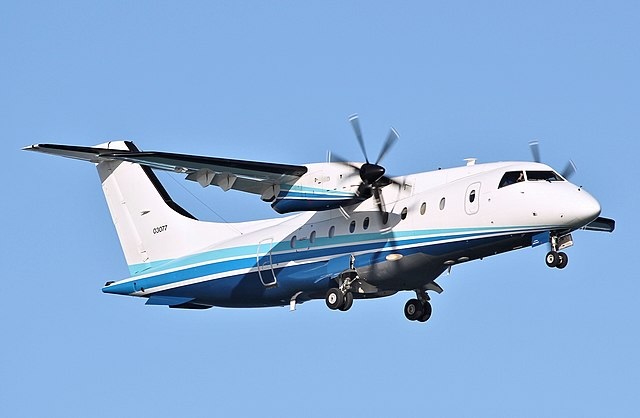Do 328
Summary
| Category | Military Transport Aircraft |
| Origin country | 🇩🇪 Germany |
| Manufacturer | Dornier |
| First flight | 6 December 1991 |
| Year introduced | 1993 |
| Number produced | 217 units |
| Average unit price | $12 million |
Description
The Dornier 328 program originated under Deutsche Aerospace ownership, driven by 1984 market research indicating demand for a fast, quiet, easily maintainable 30-seat commuter airliner. Projections estimated at least 400 units in sales, citing features rivaling jet airliners in speed with superior fuel efficiency. Following shareholder approval in December 1988, Pratt & Whitney Canada's PW119A engine was selected, along with a six-bladed composite propeller from Hartzell. A digital glass cockpit provided by Honeywell was chosen. Horizon Air placed an order for 35 aircraft in May 1991. The first prototype was formally rolled out in October 1991, and its maiden flight occurred on December 6, 1991. A second prototype followed on June 4, 1992. On October 13, 1993, the Dornier 328 officially entered commercial service.
The Dornier 328 is a twin-turboprop engined regional aircraft designed for short-haul passenger operations. The fuselage features a streamlined shape optimized for high cruising speeds, allowing the aircraft to match jetliners during landing approaches. It can operate from semi-prepared airstrips due to retractable landing gear with high-flotation tires, steerable nose gear, and a gravel guard. It is equipped with a pair of Pratt and Whitney PW119C turboprop engines, which drive fully reversible Hartzell HD-E6C-3B propellers designed for reduced noise through lower rotation speed, propeller synchrophasing, and a six-blade configuration. The fuselage allows for a three-abreast seating arrangement, with options for a denser, four-abreast configuration accommodating up to 27 passengers. The pressurized cabin can include a full-sized galley, toilet, and washbasin. The aircraft incorporates a supercritical wing design, first used on the Dornier 228, which provides cruise and climb capabilities, with construction techniques also derived from the Dornier 228 but using more composite materials in the rear fuselage and empennage. The Kevlar-carbon fiber composites reduced weight by a claimed 20%. The twin-crew glass cockpit features a Honeywell Primus 2000 avionics suite with five 20 x 17.5 cm cathode ray tube (CRT) monitors, dual integrated avionics computers, a digital databus, dual Primus II integrated radio system, and automatic flight control system.
In 2005, the Australian Maritime Safety Authority (AMSA) awarded a contract to AeroRescue to provide long-range search and rescue capability around Australia, leading to the commissioning of five 328-100s between April 2006 and February 2007. Stationed around the Australian coastline, these aircraft provided a 24-hour, 30-minute response capability. Each was equipped with an electronic sensor suite developed by Aerodata AG, which included the Israel Aerospace Industries ELTA EL/M 2022A Radar, FSI Star SAFire III Forward Looking Infra Red, Direction Finder, and an ARGON ST Infra Red/Ultra Violet scanner. They also featured an Aeronautical Engineers Australia dispatch system for dropping rescue stores via an underwing emergency exit chute, with progressive upgrades adding an in-flight-opening cargo door for dispatching larger items. These aircraft were eventually replaced by a fleet of CL604 jets under contract to AMSA. The United States Air Force's Air Force Special Operations Command also operates twenty Dornier 328s, designated as C-146A Wolfhounds.
Main Variants:
-
328-100: The initial production version of the Dornier 328 turboprop airliner.
-
328-110: An enhanced standard version of the 328, featuring greater range and higher weight capacities.
-
328-120: A variant of the 328 optimized with improved short takeoff and landing (STOL) performance.
-
328-130: A modified 328 model that incorporates progressive rudder authority reduction at higher airspeeds.
-
328JET: A turbofan-powered variant, previously known as the 328-300, offering jet performance.
Technical specifications
| Version: Do 328-110 | |
|---|---|
| Wing area | 40 m² (430.6 sqft) |
| Wingspan | 21.0 m (68.8 ft) |
| Height | 7.2 m (23.8 ft) |
| Length | 21.1 m (69.3 ft) |
| Service ceiling | 9,455 m (31,020 ft) |
| Empty weight | 8,920 kg (19,665 lbs) |
| Max. takeoff weight | 13,990 kg (30,843 lbs) |
| Powerplant | 2 x turboprops Pratt & Whitney Canada PW119B delivering 1400 kW each |
Current operating countries
| Country | Units | ||
|---|---|---|---|

|
United States | 21 | |
All operators
